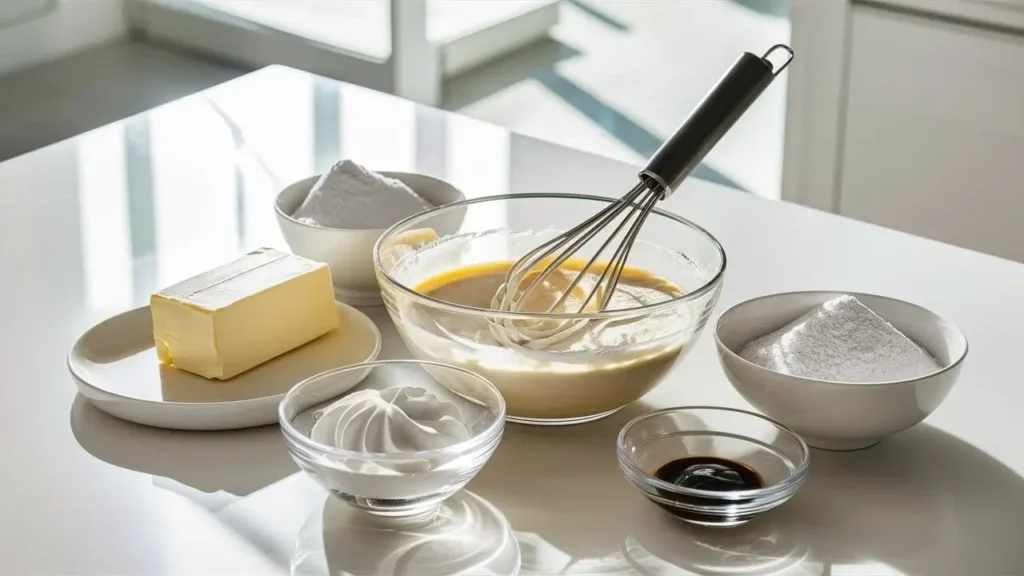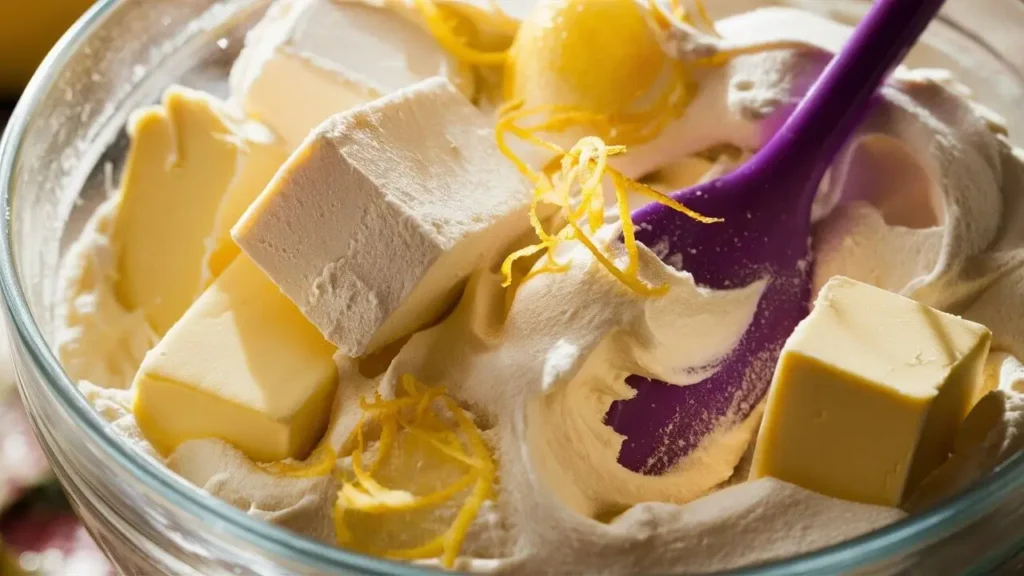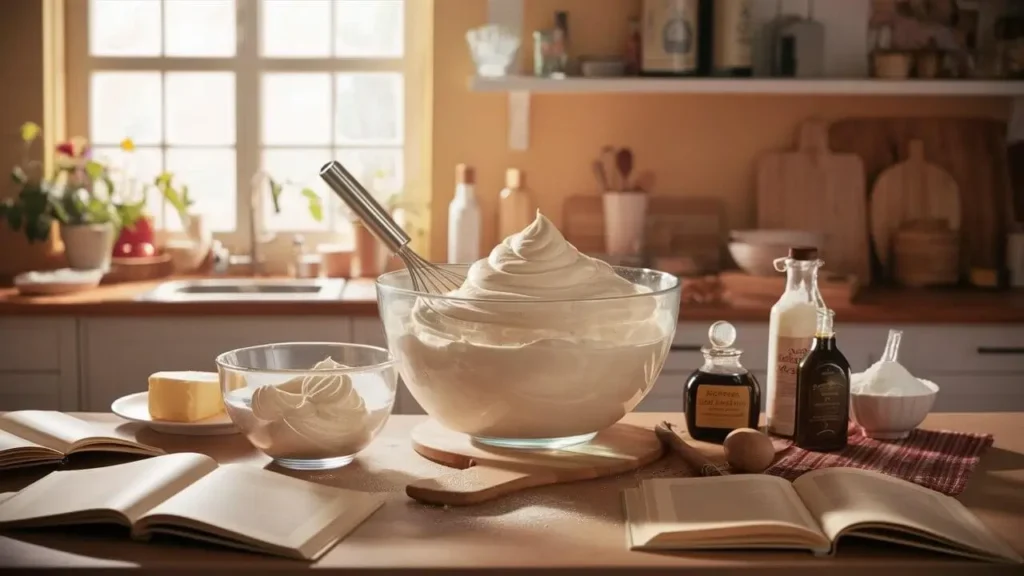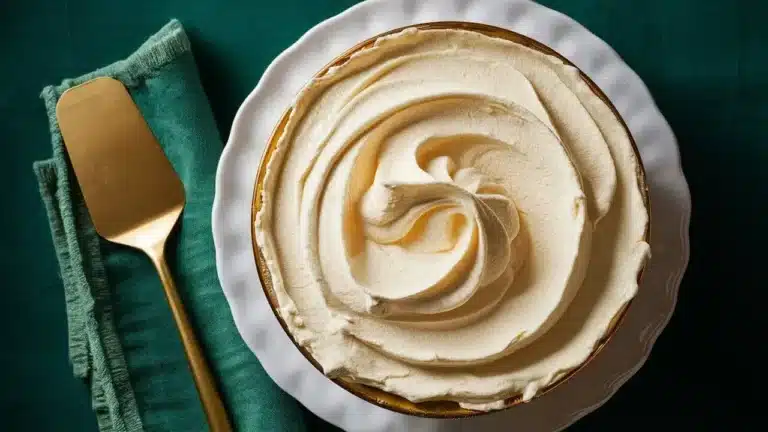Ever dreamed of making a cream cheese filling that takes your desserts to the next level? I recall watching my grandmother make a silky smooth filling that wowed everyone at family gatherings.
Making the perfect cream cheese filling is an art. Professional bakers use precision and secret techniques to make their desserts stand out. These secrets can turn your homemade treats into bakery-quality delights.
Whether you’re making a classic carrot cake or trying new dessert recipes, knowing how to make this cream is key. This guide will share the professional tips that make your filling a culinary masterpiece.
Table of Contents
Key Takeaways
- Achieve bakery-level cream cheese filling with professional techniques
- Learn the importance of ingredient temperature and quality
- Discover how to prevent lumpy or runny fillings
- Understand the science behind perfect texture
- Master quick and foolproof mixing methods
Understanding the Basics of Perfect Cream Cheese Filling
Making a delicious cheesecake filling is more than just mixing ingredients. It’s about knowing the basics that turn cream cheese into a smooth, rich treat.
Cream Cheese Selection Matters
For your cheesecake filling, pick full-fat, block-style cream cheese. Brands like Philadelphia and Kraft are great for baking. Stay away from low-fat or spreadable types, as they can ruin the texture.
- Full-fat cream cheese provides better stability
- Block-style ensures smoother consistency
- Recommended brands guarantee quality results
Essential Equipment for Cheesecake Filling
Getting the right tools is key for professional results. Invest in quality equipment to make your cheesecake filling prep easy.
| Tool | Purpose |
|---|---|
| Stand Mixer | Ensures smooth, lump-free mixing |
| Rubber Spatula | Scrapes bowl sides for even blending |
| Piping Bag | Provides precise filling application |
| Piping Tips (#14, #16 star or #6 round) | Creates professional decorative effects |
Temperature: The Secret Ingredient
Temperature is key in making cheesecake filling. Let cream cheese warm up to room temperature. You can leave it out for 30-60 minutes or microwave it for 10-15 seconds.
“The right temperature can make or break your cream cheese filling’s texture.”

Managing temperature right ensures a smooth, creamy filling. This will take your desserts from good to amazing.
Key Ingredients for a Silky Smooth Texture
Making the perfect cream cheese cake filling starts with choosing top-notch ingredients. These ingredients work together to give your filling a luxurious feel. Knowing how each part works is key to success.

The base of a great cream cheese cake filling is premium cream cheese. Full-fat cream cheese is essential for its richness and stability. This makes the filling truly special.
Essential Ingredients for Cream Cheese Cake Filling
- 8 oz full-fat cream cheese (room temperature)
- ¾ cup extra-fine caster sugar
- 1½ cups cold heavy whipping cream
- 2 teaspoons vanilla bean paste or extract
“The secret to a perfect cream cheese cake filling lies in the quality of ingredients and precise preparation.”
Every ingredient is vital for that silky smooth texture. Cream cheese gives the filling its structure. Heavy cream adds lightness. Vanilla boosts the flavor, and sugar adds sweetness and stability.
| Ingredient | Function in Filling | Recommended Amount |
|---|---|---|
| Cream Cheese | Creates base texture | 8 oz (full-fat) |
| Caster Sugar | Adds sweetness and stability | ¾ cup |
| Heavy Cream | Provides lightness | 1½ cups |
| Vanilla Extract | Enhances flavor | 2 teaspoons |
Pro tip: Always use room temperature ingredients for a smooth filling. Cold ingredients can make the filling grainy, which is not what you want in a dessert.
The Science Behind Cream Cheese Filling
Learning about cream cheese filling can really improve your baking and cooking. It’s all about the science behind that creamy texture. When you make this cream, you’re working with some amazing molecular magic.
Fat Content and Stability
The fat in cream cheese is key to its smoothness. Cream cheese must have at least 33% milk fat, as the FDA requires. This high fat content gives the filling its rich, creamy feel.
- Full-fat cream cheese provides maximum stability
- Fat molecules contribute to structural integrity
- Higher fat content ensures smoother consistency
Sugar’s Role in Texture
Sugar does more than add sweetness to your cream. It also helps keep it moist and smooth. When you’re making cream remember sugar’s role in texture is crucial.
“Sugar isn’t just about sweetness – it’s a texture architect.” – Culinary Science
Temperature Effects on Consistency
Temperature greatly affects your cream cheese filling’s texture. The fermentation happens around 22°C (72°F) with pH levels between 4.4 and 4.9. These conditions affect the protein structure and the filling’s quality.
Pro tip: Always use room temperature ingredients for the best cream. This ensures the filling mixes well and stays consistent.
Step-by-Step Mixing Technique
Making the perfect cream needs precision and care. The mixing method greatly affects your cheesecake’s texture. To start, choose the right ingredients and approach.
Here’s how to prepare your cream cheese filling:
- Take cream cheese out of the fridge 30-45 minutes before mixing
- Make sure all ingredients are at room temperature
- Use a stand mixer for the best results
- Start mixing at low speed to avoid air bubbles
“Smooth and creamy is the ultimate goal for your cream cheese filling”
Your mixing technique is key to the filling’s texture. Overmixing can add too much air, making the filling unstable. You want a silky smooth consistency without overbeating.
| Mixing Tool | Recommended Speed | Mixing Duration |
|---|---|---|
| Stand Mixer | Low to Medium | 2-3 minutes |
| Hand Mixer | Low | 3-4 minutes |
To make the best cream, follow these mixing tips. Add ingredients slowly, scrape the bowl often, and stop mixing when it’s smooth and even.
Mastering the Perfect Cream Cheese Filling Consistency
Creating the perfect cream cheese cake filling needs precision and knowing about texture. Your success comes from mastering small techniques that turn a good filling into an amazing one.
Getting the right consistency for your cream cheese puff pastry or cake filling is key. The right texture can make or break your dessert’s appeal and taste.
Achieving the Ideal Thickness
When working with cream cheese cake filling, thickness is crucial. You want a smooth, spreadable consistency that holds its shape without being too dense or runny.
- Use room temperature cream cheese (72-75°F)
- Beat ingredients for no more than 1 minute
- Aim for a final temperature around 60°F for optimal spreadability
Troubleshooting Common Texture Issues
Texture problems can quickly ruin your cream. Knowing how to fix these issues is key for baking success.
| Issue | Solution |
|---|---|
| Runny Filling | Add 1/2 cup powdered sugar or chill for 30 minutes |
| Grainy Texture | Ensure ingredients are room temperature |
| Too Firm | Add milk by teaspoon until desired consistency |
Testing for Readiness
Determining if your cream cheese filling is ready needs careful observation. A perfectly prepared filling should:
- Spread smoothly without breaking
- Hold its shape when piped
- Have a silky, uniform appearance
“The secret to perfect cream cheese filling is patience and precision.” – Professional Pastry Chef
By following these guidelines, you’ll make a cream cheese filling that takes your desserts from good to extraordinary.

Flavor Variations and Add-ins
Take your cheesecake filling to the next level with creative flavors. By adding unique ingredients, you can turn your cream cheese cake filling into a masterpiece. These add-ins will make your taste buds dance with joy.
- Classic Enhancements
- Vanilla bean specks (scrape seeds from one vanilla bean)
- Fresh lemon zest
- Pure almond extract
- Decadent Chocolate Variations
- ½ cup unsweetened cocoa powder
- 2 tablespoons dark chocolate melted
- Fruit-Inspired Options
- ¼ cup fresh strawberry puree
- Raspberry compote
- Passion fruit reduction
When adding flavors to your cream cheese cake filling, remember these crucial tips:
- Start with small quantities
- Gradually incorporate add-ins
- Maintain the original texture
- Taste and adjust seasonings
“The secret to an incredible filling is balancing flavor intensity with structural integrity.” – Pastry Chef Recommendation
Try unique combinations like maple cinnamon (1 teaspoon ground cinnamon + 2 tablespoons pure maple syrup) or bourbon pecan (2 tablespoons bourbon + ½ cup finely chopped pecans). These will make your cream cheese filling a hit with your guests.
Storage and Make-Ahead Tips
Learning how to make cream cheese filling ahead of time needs careful storage tips. Keeping it fresh means using the right methods to keep it smooth and tasty.
Proper Container Selection
For storing your cream cheese filling, pick containers that keep moisture and smells out. Glass or top-notch plastic containers with tight lids are best for keeping it fresh.
- Use containers with secure, leak-proof lids
- Select containers that are freezer and refrigerator safe
- Opt for containers that minimize air exposure
Temperature Guidelines
Keeping the right temperature is key for fresh cream cheese filling. Philadelphia cream cheese stays good at room temperature for up to 1 hour. For longer, it needs to be chilled.
| Storage Location | Maximum Duration |
|---|---|
| Room Temperature | 1 hour (before opening) |
| Refrigerator | Up to 10 days |
| Freezer | Up to 3 months |
Shelf Life Information
Knowing how long it lasts helps avoid waste and keeps your filling safe. Use opened cream cheese within a few days and always in a sealed container.
Pro Tip: Always check for any unusual smell, color changes, or texture inconsistencies before using stored cream cheese filling.
Important Note: Freezing is okay, but America’s Test Kitchen says defrosted cream cheese can get gritty. It’s best in baked goods where texture changes don’t matter as much.
Best Applications for Your Filling
Your cream cheese filling is perfect for many desserts and pastries. It can make simple recipes into amazing dishes. Try it in cream cheese puff pastry or a classic cake to see the difference.
- Cheesecake layers and bases
- Cream cheese puff pastry rolls
- Danish pastry centers
- Layer cake fillings
- Stuffed French toast
- Fruit tart foundations
To use your filling well, know how to adjust its texture. For light pastries, make it smooth and spreadable. For thick cakes, a firmer filling is better.
“A great cream cheese filling can elevate any dessert from ordinary to extraordinary.” – Professional Pastry Chef
Try adding flavors like raspberry compote, chocolate shavings, or caramel drizzle to your filling. It will turn a simple cream cheese cake filling into a fancy treat.
Temperature is important. Let your filling warm up to room temperature for the best spread and texture. Chill it when not in use to keep it just right.
Conclusion
Making the perfect cream cheese filling is an art. It mixes science, technique, and creativity. You now know the basics of making Cream Cheese Filling, opening up new culinary possibilities.
The five secrets we shared will make your desserts stand out. From choosing full-fat cream cheese to mastering mixing, these tips will take your desserts to the next level.
You can now try out both sweet and savory cream cheese fillings. Add fresh herbs for a zesty savory version or fruits for a sweet one. You have the skills to impress everyone with your creations.
Remember, practice makes perfect. Each try will help you get better at making cream cheese fillings.
The secret to a great cream cheese filling is paying attention to detail. You’ve learned about temperature, ingredients, and how to balance texture and flavor. Your desserts will now have a rich, creamy filling that shows off your skills.
So, get creative and use these professional-level techniques in your baking. Your desserts will be amazing.
Keep experimenting and making your fillings your own. With what you’ve learned, you’re ready to create delicious cream cheese fillings that will be the star of any dessert.
FAQ
What type of cream cheese works best for making a filling?
Use full-fat, brick-style cream cheese for the best taste and texture. Avoid low-fat or whipped cream cheese. They can make your filling less rich and less smooth.
How do I prevent lumps in my cream cheese filling?
Soften your cream cheese at room temperature before mixing. Use a stand mixer or electric hand mixer. Beat the cream cheese alone first, then add other ingredients.
Always scrape down the sides of the bowl. This ensures all ingredients are mixed evenly.
Can I make cream cheese filling ahead of time?
Yes, you can make it ahead. Store it in an airtight container in the fridge for 5-7 days. If you freeze it, it lasts up to 2 months.
Let it come to room temperature and re-whip before using. This will make it smooth again.
How can I fix a runny cream cheese filling?
If it’s too runny, try adding a bit of powdered sugar. Chill the mixture in the fridge for 30 minutes. Or, add a tablespoon of cornstarch to thicken it.
What are some popular flavor variations for cream cheese filling?
You can add vanilla extract, lemon zest, melted chocolate, or fruit purees. Spices like cinnamon are also great. Start with small amounts and adjust to taste.
How do I know when my cream cheese filling is the right consistency?
It should be smooth and creamy. It should hold its shape but spread easily. When you lift the beater, it should form soft peaks.
Can I use cream cheese filling for different types of desserts?
Absolutely! It’s very versatile. Use it in cheesecakes, layer cakes, puff pastries, and more. Just adjust the consistency for each dessert.
What equipment do I need to make cream cheese filling?
You’ll need a stand mixer or electric hand mixer, a rubber spatula, and mixing bowls. A piping bag is useful if you plan to pipe the filling. An instant-read thermometer helps with checking ingredient temperatures.

